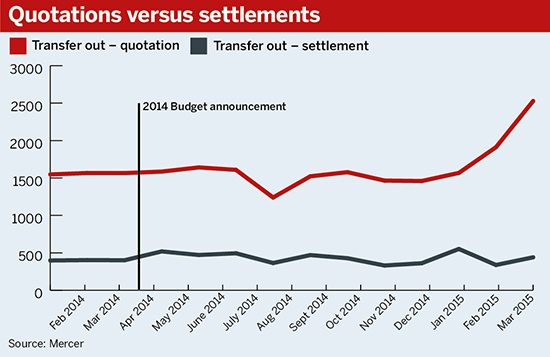Defined benefit schemes should review the shape of their liability profile and consider their investments should a high proportion of members transfer out, as figures show a sharp rise in requests.
Since the freedom and choice reforms raised the profile of defined contribution by giving members full access to their pots from age 55, the industry has found it difficult to predict the number of defined benefit members likely to transfer to DC.
While matching assets may largely offset the impact of transfers-out of larger funds, smaller schemes could see significant disruption to the distribution of their liabilities.
For example, a handful of members who have accrued a large amount of benefits could constitute a substantial portion of total liabilities in smaller schemes.
Recent data from pensions consultancy Mercer have shown the number of employees requesting transfer values for their DB savings increased by 60 per cent in the month prior to the freedoms coming into force.
During March 2015, Mercer received 2,500 transfer value requests, a sharp rise from a steady trend of around 1,500 requests a month during 2014 and the opening months of 2015. However, few requests have been converted into settlements (see graph).

Similar interest levels have been reported elsewhere across the industry.
The number of transfer value quotes requested from DB schemes administered by Towers Watson was about 75 per cent higher in March 2015 than in March 2014.
Consultancy Barnett Waddingham has seen requests treble in the 13 months since the 2014 Budget compared with the 13 months prior to the announcement.
Cash flow position
Matthew Demwell, UK head of member options at Mercer, emphasised it remains to be seen how many requests will materialise into members actually transferring their benefits into DC, but called on schemes to consider their current investment position.
“Schemes need to think about a review of their investment strategy in light of a potential uptick in transfers,” said Demwell.
He said this should include careful assessment of the way liabilities are distributed across the membership, the current cash flow position and the liquidity of scheme assets.
Hurdles to taking a transfer
Matthew Demwell, UK head of member options at Mercer, said the level of support provided by trustees and employers will be a big factor in determining the number of members transferring out.
“Trustees need to get on the front foot on this and question what they can do to ensure the right members transfer for the right reasons,” he said.
Challenges for trustees around processing transfers include:
helping members understand the options available to them;
members finding a suitable IFA and being prepared to pay for advice;
being able to demonstrate members have taken advice.
However, Simon Cohen, associate in Barnett Waddingham’s investment consultancy team, said he did not think the uptick in requests was a reflection of likely levels of transfers but said trustees should be looking at the liquidity of their portfolios anyway.
“Some asset classes [that trustees] consider to be very liquid, in current market turbulence could end up being quite illiquid,” Cohen said. “For example corporate bonds; dealing spreads have widened and there’s not much liquidity there.”
Cohen said there was an opportunity cost for schemes holding cash as a contingency plan to pay member transfer values.
“[Trustees] may be sitting on cash that may not be required at all. If someone is holding gilts or index-linked gilts, those assets will be liquid, hopefully no matter what happens,” he said. “The dealing spreads on those are quite narrow, so if push comes to shove and you need liquidity you could sell your gilts.”
But Danny Vassiliades, principal at investment consultancy Punter Southall, said schemes could sell assets when prices are high and hold some of the reward as cash if they feel there is a growing number of serious transfer candidates.
“Keep some as cash rather than just disinvesting at the last minute when [you] might find the price has dropped a little bit,” said Vassiliades.
He said it was important for trustees to have a disinvestment plan in place should a large proportion of those eligible decide to transfer out.
“Knowing what assets you’re going to sell under what conditions is important. I get this question more often with trustees – they become a net disinvestor, they’re selling assets and they think there’s something wrong with that,” he added.
Shifting duration
Processing transfers for a significant number of non-pensioner members has the potential to reduce the age profile of schemes and therefore shorten the duration of liabilities.
Vassiliades said trustees need to regularly review their liability-driven investment portfolios to ensure hedges are consistent with shifts in duration.
“If they’re too long [in duration] they may have too much interest rate protection, which could work against them if interest rates move up,” he said.














